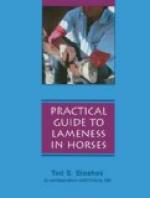There is no particular difference in the handling of carpal luxation and dislocation of other bones. Where ligaments have not been destroyed to the extent that reduction is of no practical use, the parts are kept immobilized, if thought necessary. Later, vesication of the whole pericarpal region is done and the subject allowed exercise at will.
Carpitis.
Etiology and Occurrence.—Inflammation of the carpus is caused by contusions, such as are occasioned in falling, by kicks by striking the carpus against objects in jumping and sometimes by striking it against the manger in pawing. The condition is of rather frequent occurrence.
Symptomatology.—Evident symptoms of inflammation in carpitis are always present—hyperthermia, supersensitiveness and swelling. Also, there exists lameness which is characterized by an apparent inability to flex the leg, and there is circumduction of the leg as it is advanced because in this way little if any flexion of the carpus (which increases pain) is necessary.
Depending upon the nature of the cause, there occurs a marked difference in the character and amount of swelling.
[Illustration: Fig. 11—Pericarpal inflammation and enlargement due to injury.]
Naturally, when much extravasation of serum and blood takes place, there is occasioned a fluctuating swelling which is usually less painful to the subject upon manipulation than is a dense inflammatory change without marked extravasation.
In acute carpitis, there is present, then, a very painful condition which involves the articulation, causing marked lameness, disturbance of appetite and some elevation of temperature.
Chronic cases do not occasion serious pain or constitutional disturbances, but do interfere with locomotion in direct proportion to the existing articular inflammation and periarticular hypertrophy of ligamentous and tendinous structures.
Treatment.—If possible, keep the subject absolutely quiet, employing the sling if necessary. During the first stages of inflammation, the application of ice packs to the affected parts, is of marked benefit. At the end of forty-eight hours, hot applications may be used and this treatment continued throughout several days. Anodyne liniments are of service and should be employed throughout the acute stage of inflammation during intervals between the hydrotherapeutic treatments.
As inflammation subsides, a counterirritating application such as a suitable liniment and later blistering or line-firing is helpful in stimulating resolution.
[Illustration: Fig. 12—Hygromatous condition of the right carpus, also distension of sheaths of extensor tendons of both fore legs.]
Open Carpal Joint.




